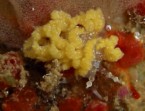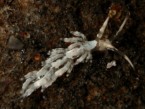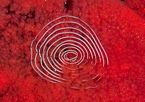| Home |
| Acknowledgments |
| Conventions |
| Glossary |
| Maps |
| References |
| Links |
| Articles |
| Thumbnails |
| Species
list |
| Family |
| Next
species |
Additional Photos

side

underside

white

yellow

four swellings

young

feeding

egg mass
_______________
GALLERY

Favorinus japonicus Baba, 1949

| Maximum size: 17 mm (Kay,
1979). Identification: This aeolid has a translucent white body with opaque white patches on the head and along the length of the notum. The color of its cerata varies depending on what type of eggs it has been eating--generally in Hawaii they range from white/brown to yellow to pink. The rhinophores are translucent at the base, white at the tips and have two to three (rarely 4) swellings. It may be distinguished from Favorinus sp. #1 by the lack of violet spots in the tips of its cerata. It may be distinguished from Favorinus sp. #2 by its nodular cerata and lack of orange-brown spots in the tips of its cerata. Natural history: Favorinus japonicus is a common species that can be more easily found than many other aeolids due to its habit of eating (and laying eggs on) the egg masses of other opisthobranchs, particularly those of Hexabranchus spp. However, it's primarily nocturnal and may also be found crawling in the open at night, presumably seeking mates or new egg masses to feed on. It inhabits moderately protected to highly exposed rocky environments as well as Halimeda kanaloana beds from < 1 to 27 m (< 3 to 90 ft). It may eat a wider variety of opisthobranch egg masses than other Favorinus spp. (Note 1) Retention of pigments from its food produces its highly variable background coloration. It lays a white egg mass of many low whorls, often on the egg mass it's feeding on. In the latter case, in order to survive, its eggs must hatch before or just after the food egg mass, probably in less than a week. Distribution: Big Island, Maui, Lanai, Oahu and Kauai: widely distributed in the Indo-Pacific. Taxonomic notes: It's referred to as the "egg-eating nudibranch" in Hoover, 1998 & 2006 and was first reported from Hawaii in Gosliner, 1980. There's some chance that the bluish-white animal with four swellings on its rhinophores could be distinct. Photo: PF: 11 mm: off Lualailua, Maui; March, 1990. Observations and comments: Note 1: We've seen (or have photos of) them on egg masses of Dolabrifera dolabrifera, Hexabranchus and other dorids. Records of them eating sacoglossid (and pleurobranch/umbraculid?) masses are uncertain due to ambiguous IDs. Kay, (1979) reports them eating Aplysia, Dolabrifera and Melibe eggs. Bertsch & Johnson (1981) reports them eating Hexabranchus and Aplysia eggs. |
| Thumbnails |
Species
list |
Family | Next species | Top |